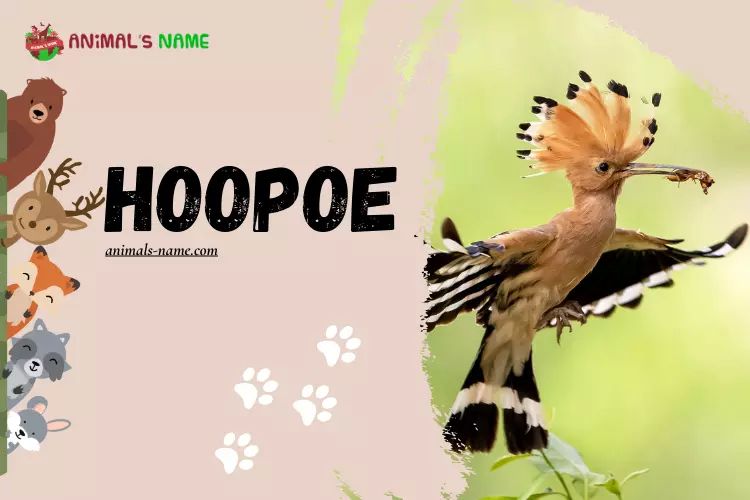We are introducing the fascinating world of birds! Today, we bring you a special feature on a unique feathered creature, the Hoopoe. With its surprising history, interesting facts, remarkable size, preferred habitat, and classification, this article offers a brief glimpse into the wonders of this extraordinary bird.
The Hoopoe has a rich historical background that traces back thousands of years. Referred to in ancient Egyptian, Greek, and Roman texts, this remarkable bird has captured the imagination of people throughout time. Renowned for its distinctive crown of feathers and beautiful colouration, the Hoopoe stands out among its avian counterparts.
Moving on to the facts, did you know that the Hoopoe is not just a regular bird? It possesses unique talents, such as extracting insects from the ground using its long bill. Additionally, this bird has earned its reputation as a skilled thief due to its sneaky habit of stealing other birds’ nests!
In terms of size, the Hoopoe is relatively small, measuring around 25 centimetres in length. It showcases a long, thin beak and an elegant body covered in brown, white, and black feathers, making it a sight to behold.
The Hoopoe prefers to make its home in open woodlands, savannas, or gardens with ample trees and shrubs. It thrives in regions with warm climates, such as Europe, Asia, and North Africa. You might even be lucky to spot one of these magnificent creatures in your backyard!
Finally, when it comes to classification, the Hoopoe falls under the Coraciiformes order, standing next to its avian relatives such as kingfishers and bee-eaters. Within this order, the Hoopoe belongs to the Upupidae family, making it a truly distinct and remarkable species.
And that concludes our brief but exciting introduction to the captivating world of the Hoopoe. Don’t forget to explore our website, where you can find a comprehensive article on 155+ Animals Name, including a detailed account of this incredible bird. So, join us as we delve further into the realm of these magnificent creatures that grace our world with their presence.
History of Hoopoe
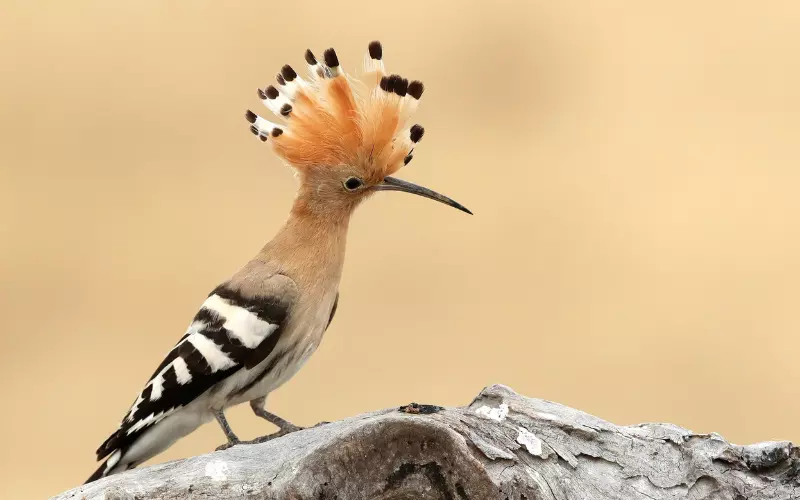
The Hoopoe bird has a fascinating history that goes back thousands of years. In ancient Egyptian culture, the Hoopoe was considered a sacred bird. It was associated with the Sun God Ra and was believed to have special powers, such as bringing good luck and protecting against evil spirits. The Egyptians even believed that the Hoopoe could bring messages from the gods.
Moving on to ancient Greek and Roman times, the Hoopoe was often depicted in art and literature. It was admired for its distinctive crown of feathers and its beautiful plumage. The Greek philosopher Aristotle dedicated a whole chapter to this bird in his book on animals. The Hoopoe symbolized beauty and elegance, and it was considered a symbol of wisdom and intelligence.
Throughout history, the Hoopoe has also been mentioned in religious texts. For example, the Hoopoe is referenced as an unclean bird in the Old Testament. However, in the Quran, the Hoopoe plays a more positive role. It is mentioned in the story of King Solomon, who could communicate with animals, including the Hoopoe. In the Quran, the Hoopoe is described as a loyal messenger and a symbol of attentive obedience.
The Hoopoe bird has a rich and diverse history. Different cultures have cherished it for its beauty, symbolism, and supposed powers. From ancient Egypt to Greek and Roman civilizations, and even in religious texts, the Hoopoe has left its mark throughout history. It continues to be admired and studied by people worldwide, reminding us of the beauty and wonder of nature.
Importance of Hoopoe
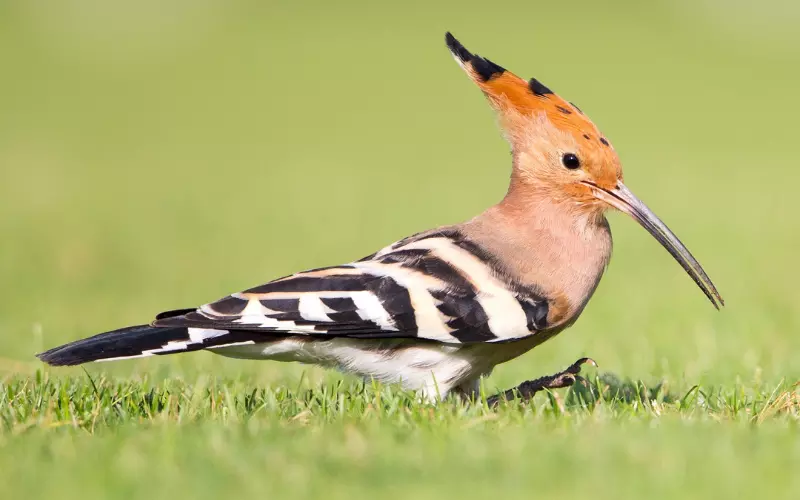
The Hoopoe bird is essential for many reasons. First of all, it helps to control the insect population. The Hoopoe eats a lot of insects, especially harmful ones like beetles and termites. By eating these insects, the Hoopoe helps keep the balance in nature and prevents pests from destroying our plants.
Another critical role of the Hoopoe bird is in seed dispersal. When the Hoopoe bird eats fruits or berries, it swallows the seeds too. Later, when the Hoopoe flies to another place, it poops out the seeds, which then grow into new plants. This helps to spread plant species and increase biodiversity in different areas.
Lastly, the Hoopoe bird is also important because it is a good indicator of the health of our environment. If there are a lot of Hoopoe birds in an area, it means that the ecosystem is healthy and well-balanced. On the other hand, if the number of Hoopoe birds decreases, it may be a sign that something is wrong, like pollution or habitat destruction.
To sum up, the Hoopoe bird is essential in controlling insects, spreading seeds, and indicating the environment’s health. It is a fascinating creature that contributes to the well-being of our planet. So, let’s appreciate and protect the Hoopoe bird for its valuable services to us and the Earth.
Amazing Facts About Hoopoe
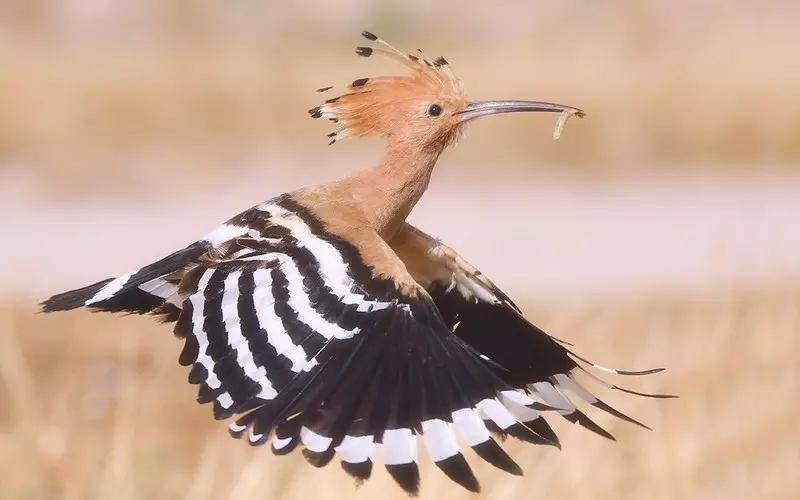
1. The hoopoe bird is a medium-sized bird that measures 9 to 12 inches long.
2. It has a unique appearance with a crown of long, thin feathers on its head that can be raised or fanned out like a crown.
3. Hoopoes have a distinctive call, often described as a “hooo-po” sound, which gives them their name.
4. These birds can be found in various regions worldwide, including Africa, Eurasia, and the Indian subcontinent.
5. The hoopoe bird has colourful plumage, combining black, white, and shades of brown on its body.
6. Its wings have black and white stripes, making it easily recognizable in flight.
7. Hoopoes have long, curved beaks that they use to probe the ground in search of insects and larvae.
8. They mainly feed on insects, such as beetles, ants, and grasshoppers, but also consume fruits and berries.
9. These birds are known for their robust and undulating flight pattern, flapping their wings alternately with short glides.
10. Hoopoes are monogamous birds and typically mate for life.
11. They build their nests in cavities like tree holes, rock crevices, or even termite mounds.
12. The female hoopoe lays about 4 to 7 eggs, which she incubates for 15 to 18 days.
13. The male and female take turns incubating the eggs and feeding the chicks once they hatch.
14. Hoopoe parents regurgitate food to feed their young until they are old enough to forage independently.
15. Despite being relatively common, hoopoe populations in some areas have declined due to habitat loss and pesticide use.
Can we keep Hoopoe as our Pet?
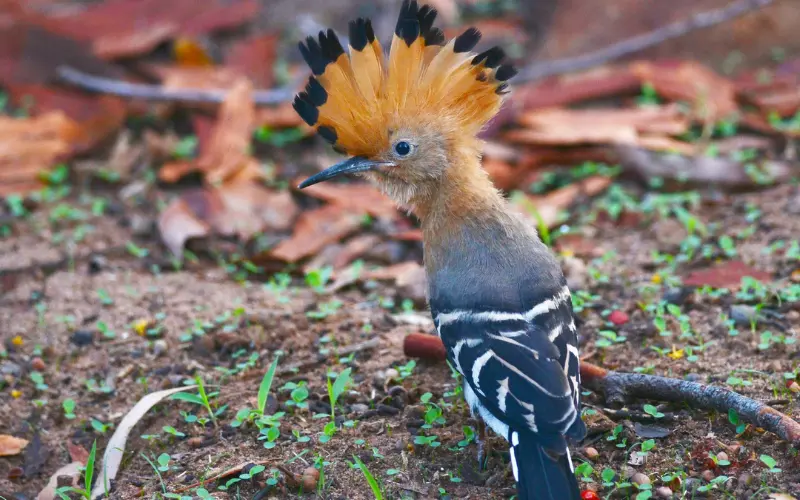
The Hoopoe bird is a beautiful and unique creature that many people find fascinating. However, keeping a Hoopoe bird as a pet is not suitable. These birds are meant to live in the wild and have specific needs that are difficult to meet in a home environment.
Firstly, Hoopoe birds are migratory and travel long distances during different seasons. Keeping them confined in a cage can be highly stressful and unhealthy for them. They need the freedom to fly and explore, which cannot be provided in a domestic setting.
Secondly, it is essential to consider the conservation status of Hoopoe birds. Unfortunately, Hoopoes have experienced a population decline, and some are even considered extinct in certain areas. Protecting these birds and their natural habitats is essential to prevent further decline. Keeping them as pets only contributes to their extinction, disrupting their natural reproduction cycle.
It is not appropriate or ethical to keep Hoopoe birds as pets. They are wild creatures that require freedom and natural surroundings to thrive. Moreover, with their decreasing numbers, it is crucial to focus on conserving their species rather than capturing them as pets. So, let’s appreciate their beauty from afar and work towards preserving their existence in the wild.
Size of Hoopoe
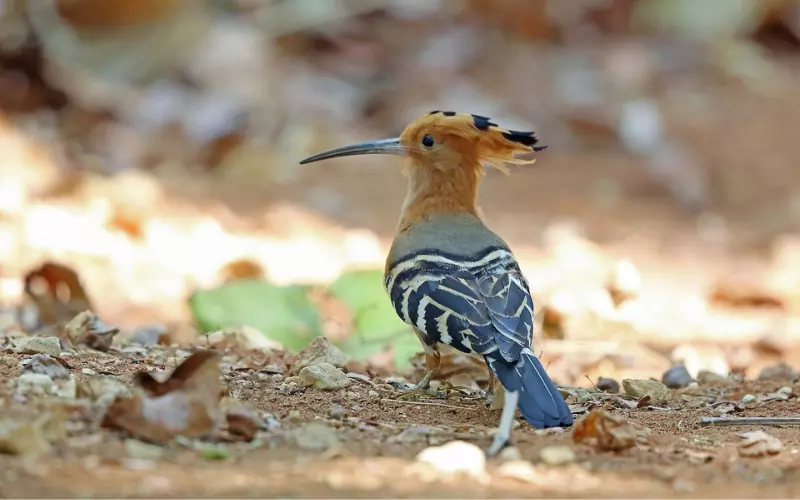
The Hoopoe bird is a small-sized bird that measures about 25 to 29 centimetres, similar to the height of a regular ruler used in school. It weighs around 46 to 89 grams, about the same as a small apple or a medium-sized tomato.
The Hoopoe bird has a distinct appearance with a long beak, a crown of feathers, and a long, thin crest. It has a beautiful combination of colours: a cinnamon brown body, black and white striped wings, and a black, curved beak. Its crest can pop up or lie flat on its head, depending on its mood or situation.
Despite being small in size, the Hoopoe bird has impressive abilities. It is known for its strong wings that enable it to fly long distances and reach great heights. It has a wingspan of approximately 44 to 48 centimetres, about the same as the width of a standard backpack. This allows the Hoopoe to glide gracefully through the air and navigate different landscapes.
The Hoopoe bird is small, measuring around 25 to 29 centimetres and weighing about 46 to 89 grams. It has a striking appearance with its long beak, crown of feathers, and a thin crest on its head. Despite its small size, it possesses strong wings that allow it to fly easily and gracefully.
Habitat of Hoopoe
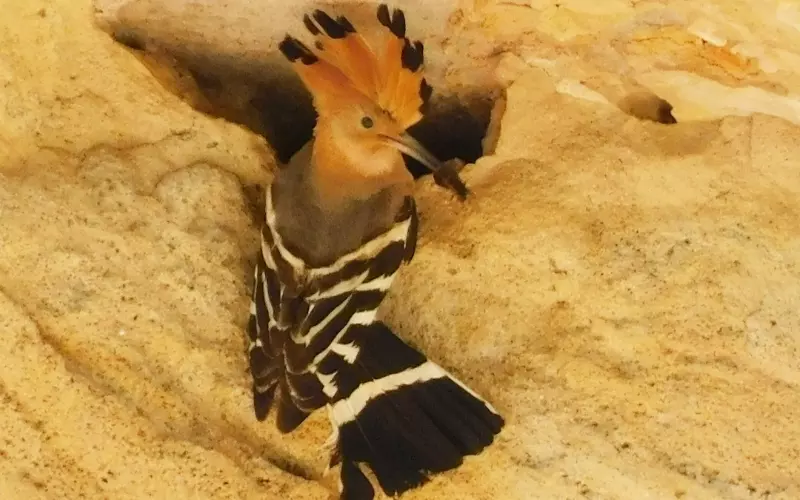
The hoopoe bird is commonly found in various parts of the world, including Europe, Asia, and Africa. It is known for its distinctive appearance and unique behaviours. The habitat of the hoopoe bird typically consists of open woodland areas, savannahs, and grasslands. It prefers habitats with trees and bushes, where it can find suitable nesting spots and feed on insects.
In open woodlands, hoopoe birds can often be spotted resting on tree branches, using their long bills to probe the ground for insects. They are especially fond of areas with a mix of trees and open spaces, providing the perfect balance of shelter and food sources. Savannahs and grasslands also provide suitable habitats for hoopoes, as these environments offer ample opportunities to find beetles, ants, and other small creatures to feast upon.
Regarding nesting, hoopoes prefer natural tree hollows or cavities in rocks. However, they have also utilised man-made structures such as nesting boxes or wall holes. Hoopoe birds are known for their distinctive nest-building abilities, creating nests with soft materials such as leaves, grass, and feathers. These nests are usually well hidden and placed high off the ground to ensure the safety of the eggs and chicks.
The hoopoe bird’s habitat is diverse, ranging from woodlands to grasslands, where it can find plenty of insects to eat and suitable nesting spots. By adapting to natural and man-made structures, the hoopoe has demonstrated its ability to survive in various environments, making it a fascinating bird to observe and learn about.
Evolution of Hoopoe
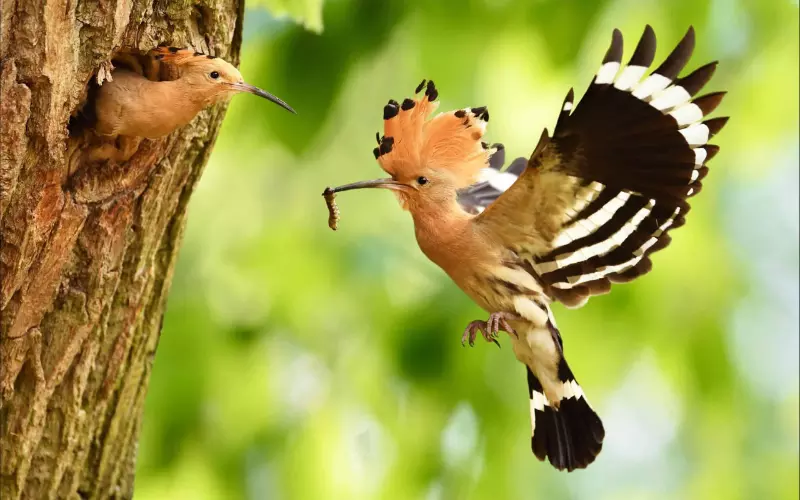
The Hoopoe bird has gone through a remarkable evolution over millions of years. Long, long ago, the ancestors of Hoopoe had sharp beaks and strong claws that helped them catch insects and small creatures. As time went on, their bodies started to change. They developed a special crowned crest and beautiful feathers with intricate patterns on their heads. These changes allowed the Hoopoe birds to display their elegance and beauty.
The Hoopoe bird has adapted to different environments, making it a versatile survivor. These birds can be found in various parts of the world, from Europe to Africa to Asia. They have learned to thrive in different habitats, such as forests, grasslands, and deserts.
One of the most fascinating features of the Hoopoe bird is its distinct call. They produce a unique “hoop-hoop” sound. This call is a way for the birds to communicate with each other and a means to attract a mate during the breeding season. The enchanting sound echoes through the air, making the Hoopoe birds easily distinguishable.
Overall, the Hoopoe bird has evolved to become a splendid creature throughout history. Its physical features, adaptability, and melodious call make it stand out among other birds. The evolutionary journey of the Hoopoe bird is a testament to the diverse and extraordinary nature of life on Earth.
Classification of Hoopoe
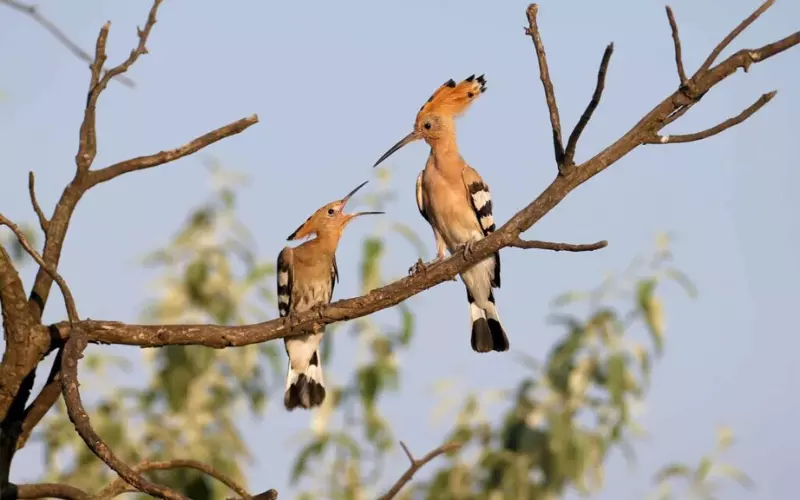
The hoopoe bird belongs to the animal kingdom, the phylum Chordata, the class Aves, the order Coraciiformes, and the family Upupidae. It is a unique and fascinating bird in various parts of the world, including Europe, Asia, and Africa.
The hoopoe bird is commonly known for its distinctive appearance. It has a long curved bill, a crested head, and beautiful crown feathers that resemble a fan when raised. The plumage of the hoopoe is a mix of brown, white, and black, giving it a striking and attractive look. Furthermore, it has a body length of approximately 25-30 centimetres and is known for its unique and harmonious call.
Regarding its classification, the hoopoe bird is part of the Coraciiformes order, which includes other bird families such as kingfishers and bee-eaters. It is categorized under the Upupidae family, which consists solely of one genus, Upupa, and a few species. The hoopoe bird’s scientific name is Upupa epops, the only recognized species within this genus. This bird is renowned for its ability to use its specialized bill to probe the ground in search of food, such as insects, worms, and small reptiles.
To sum up, the hoopoe bird is a unique and captivating creature classified under the avian group. It is part of the Coraciiformes order and belongs to the Upupidae family. The hoopoe bird continues to captivate people’s attention worldwide with its distinct appearance, including its crest and colourful plumage.
Different Types of Hoopoe
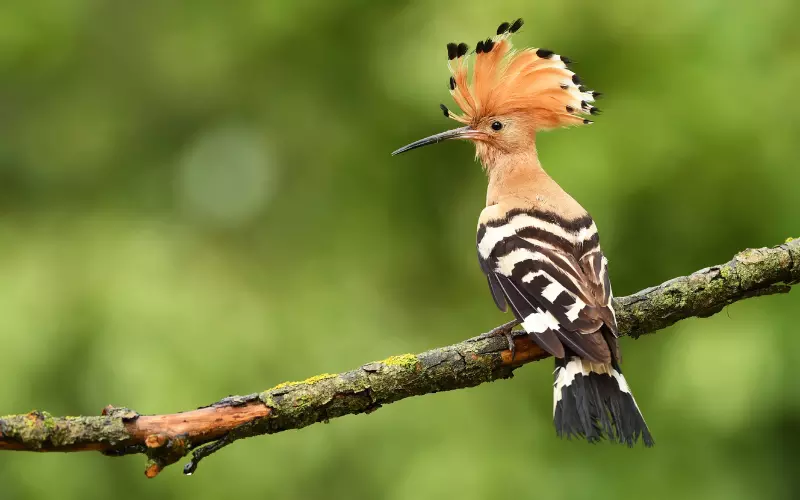
1. Wahinii Hoopoe Bird: This type of hoopoe bird is known for its vibrant plumage, which includes a mix of black, white, and reddish-brown feathers. It is commonly found in Central and East Africa, and its distinctive call can be heard echoing through the forests and savannah.
2. Eurasian Hoopoe Bird: Found in Europe, Asia, and North Africa, the Eurasian hoopoe is known for its unique long, thin beak, curved crest, and beautiful combination of pink, black, and white feathers. It is a migratory bird and possesses a melodious song.
3. Madagascan Hoopoe Bird: Native to the island of Madagascar, this hoopoe species has a crest that resembles a crown. It has a range of calls, including a loud and repetitive “hoop hoop hoop” sound. Its striking plumage includes a mix of black, white, orange, and brown feathers.
4. Malabar Hoopoe Bird: This hoopoe species can be found in the Western Ghats of India. It is known for its long, slender bill and distinctive crest, tipped with black feathers. Its plumage features shades of black, white, brown, and orange, giving it a unique appearance.
5. African Hoopoe Bird: Commonly found in sub-Saharan Africa, it is recognized by its bold black and white stripes on its wings and tail. Its call is a distinctive “hoo-poo-poo” sound. It is known to feed on insects, utilizing its strong beak to catch its prey.
6. Malachite Hoopoe Bird: Native to countries such as South Africa, Mozambique, and Zimbabwe, the malachite hoopoe is named after its vibrant green colour feathers, resembling the precious gemstone malachite. It has a long, curved beak and can often be spotted hopping on the ground for food.
7. Abyssinian Hoopoe Bird: This hoopoe species is found in North Africa and the Arabian Peninsula. It has a unique crest that can be raised or lowered as a form of communication. Its distinctive call is a musical “oop-oop-oop” sound.
8. White-headed Hoopoe Bird: Native to sub-Saharan Africa, this hoopoe species has a white head, black body, and a black and white crest. It is known for its acrobatic flying abilities and can often be seen catching insects mid-air with its sharp beak.
9. Red-wattled Hoopoe Bird: This hoopoe species is found in parts of South Asia, including India, Nepal, and Sri Lanka. It is recognized by its red facial skin and wattles, as well as its unique call, described as a metallic “tuk-tuk” sound. Its plumage showcases shades of brown, black, and white.
10. White-browed Hoopoe Bird: Native to parts of East and Southern Africa, the white-browed hoopoe has a distinct white eyebrow patch and a mixture of black, white, and brown feathers. It is known for its impressive courtship dance, where it bobs, flaps its wings, and calls with a distinct “hoop” sound.
Geographical Presence of Hoopoe

The Hoopoe Bird is found in Europe, Asia, and parts of Africa. It is a migratory bird, which means it moves from one place to another depending on the time of the year. During the breeding season, it can be seen in countries like Spain, Greece, and Turkey, while during the winter months, it may travel to Northern Africa or even as far as India.
However, there are some regions where the Hoopoe Bird is not found. It does not inhabit the Americas, including North and South America. It is also absent from Australia and Antarctica. These places have different climates and ecosystems, which may not be suitable for the bird’s survival and breeding.
The Hoopoe Bird prefers areas with open grasslands, woodlands, and gardens. It often searches for food on the ground, using its long beak to catch insects and small invertebrates. It builds nests in cavities, such as hollow trees or old buildings, and lays several eggs to raise its young.
The Hoopoe Bird can be found in Europe, Asia, and Africa. It is a migratory bird that moves between different regions depending on the time of the year. However, it is not present in the Americas, Australia, or Antarctica. The Hoopoe Bird prefers open grasslands and woodlands, feeding on insects and small invertebrates.
Scientific Name of Hoopoe
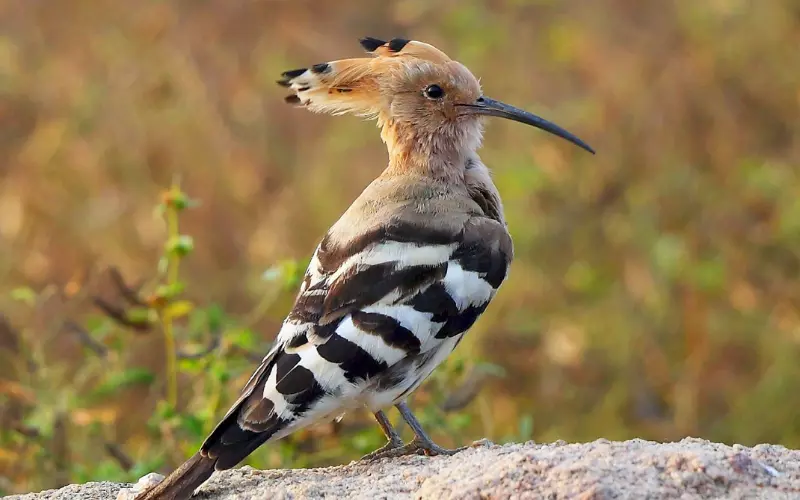
The scientific name of the Hoopoe bird is Upupa Epops. This bird is known for its bright colours and distinct appearance. Its scientific name is derived from the Latin word “Upupa,” which means hoopoe, and the Greek word “pops,” which refers to its characteristic sound.
Upupa epops belongs to the family Upupidae, and it is widely distributed across Europe, Asia, and parts of northern Africa. It is easily recognizable by its unique crest, which can be raised or flattened depending on the mood or situation. The Hoopoe has a long, thin beak, a pinkish-brown body, and striking black and white stripes on its wings and tail.
The Hoopoe bird is primarily insectivorous, feeding on various insects and their larvae, as well as small reptiles, earthworms, and even fruits. This bird is known for its distinctive “hoop hoop” call, which it produces by extending its neck and flicking its crest. The male Hoopoe performs an elaborate courtship display to attract a mate, during which it spreads its wings, bows its head, and produces a series of calls and movements.
The scientific name of the fascinating Hoopoe bird is Upupa Epops. With its unique appearance and beautiful crest, it is a bird that stands out among others. Its distinct “hoop hoop” call and courtship display add to its charm.
Diet of Hoopoe

The Hoopoe bird has a unique and exciting diet. It prefers to eat insects like beetles, ants, and caterpillars. But that’s not all! The Hoopoe also enjoys feasting on spiders, earthworms, and even small reptiles like lizards. It has a long beak that helps it catch its prey by probing the ground or picking insects from the trees.
In addition to insects, the Hoopoe bird likes to munch on fruits and seeds. It particularly enjoys berries and cherries, providing a tasty and nutritious treat. This bird is quite versatile in its diet and can adapt to different environments, allowing it to find food even in less abundant areas.
What makes the diet of the Hoopoe bird even more fascinating is its dining behaviour. It uses its long beak to extract food from the ground, especially when searching for insects. The Hoopoe often uses a unique technique called “hoopoeing,” where it bobs its head repeatedly while foraging. This movement helps it locate hidden insects or worms that it can swiftly capture and devour.
To summarise, the Hoopoe bird enjoys a diverse diet ranging from insects and spiders to fruits and seeds. Its long beak and distinct foraging technique allow it to search for and catch its favourite foods. With its resourceful eating habits, the Hoopoe bird can thrive in various environments and always find something yummy.
Locomotion of Hoopoe
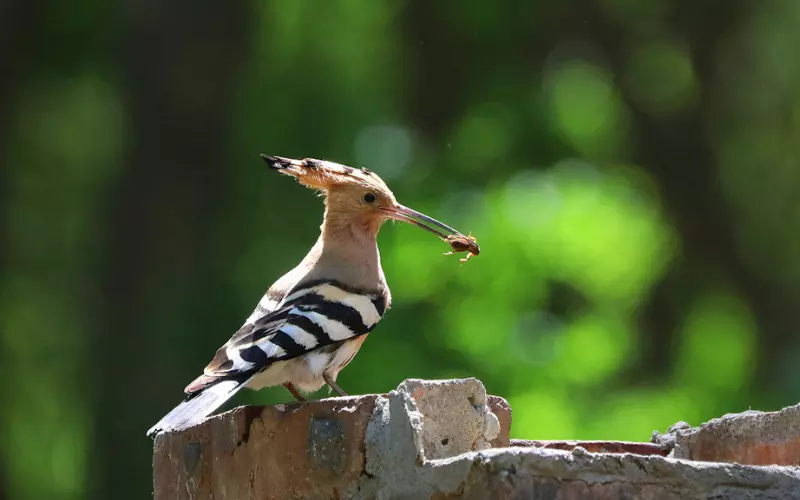
The Hoopoe bird has a unique way of moving called locomotion. It uses a combination of walking and hopping to get around. Walking, it uses its claws to grip the ground and moves one foot at a time. This helps it to maintain balance and stability. The Hoopoe also has a unique way of hopping. It jumps forward and uses its wings to gain momentum. This way, it can cover more distance in less time. The Hoopoe’s locomotion is efficient and allows it to move quickly and gracefully through its surroundings.
Social and Sexual Behaviour of Hoopoe

The Hoopoe bird has interesting behaviours regarding its interactions with other birds. These birds are quite social and like to stay connected with others of their kind. They often form small groups called flocks. These flocks can consist of their immediate family members or other birds they meet along their journey. These groups help them stay safe and find food together. They also communicate with each other through soft calls and body movements, which help them stay connected even when they are far apart.
When it comes to their sexual behaviour, Hoopoe birds have a unique way of attracting a mate. The male Hoopoe bird performs a special dance to impress the female. During this dance, he puffs up his feathers, waves his wings, and hops around funnily. This catches the female’s attention and shows her that he is strong and healthy. If the female is impressed, she may decide to mate with him. After mating, the female Hoopoe bird builds a nest to lay her eggs in. She takes care of the eggs and raises the chicks with the help of the male.
To sum up, Hoopoe birds are social and enjoy living in small flocks with their family members and other birds. They communicate with each other through calls and movements. Regarding sexual behaviour, male Hoopoe birds perform a special dance to attract a mate, and the female takes care of the eggs and chicks after mating. These behaviours help them survive and continue their species.
Reproduction and Lifecycle of Hoopoe
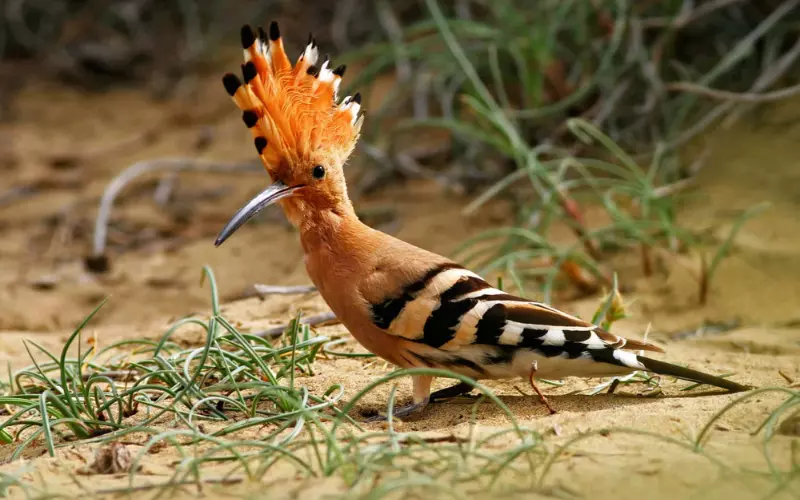
The Hoopoe bird has a fascinating reproduction and life cycle. It all starts when a male Hoopoe begins to court a female by showing off his colourful feathers and making a distinctive call. If the female is impressed, she will choose a nesting site. The pair will then work together to build a nest, usually located in a hole in a tree or ground.
The female will lay eggs once the nest is ready, usually around 4 to 6. The male and female take turns incubating the eggs, keeping them warm until they hatch. This usually takes about 15 to 18 days. After the eggs hatch, the parents continue to take turns feeding and caring for the chicks.
As the chicks grow, they develop feathers and explore their surroundings. Both parents play an essential role in feeding the young Hoopoes. They catch insects like beetles, caterpillars, and spiders and feed them to their hungry chicks. As the weeks go by, the chicks become more robust and more independent. They learn how to fly and find food on their own.
The life cycle of a Hoopoe typically lasts for about one year. After the breeding season, the adults and their young birds migrate south to warmer regions. They spend the winter in these regions before returning to their breeding grounds in the spring to repeat the cycle. This fantastic cycle continues year after year, ensuring the survival of the Hoopoe bird.
Threats to Hoopoe
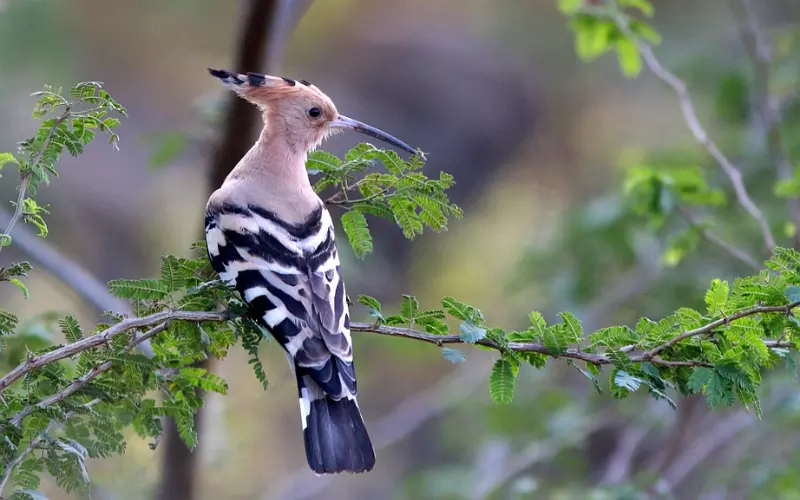
The Hoopoe bird is facing many threats that could harm its existence. One of the biggest threats to these beautiful birds is habitat destruction. As forests are cut down to make way for buildings and farms, the Hoopoe’s natural homes are disappearing. Without a suitable habitat, the birds struggle to find food and build nests, which can lead to a decline in their population.
Another major threat to the Hoopoe bird is pollution. Humans often release harmful environmental chemicals, such as pesticides and oil spills. These pollutants can contaminate the Hoopoe’s food sources, making them sick or even causing death. Additionally, pollution can lead to habitat degradation, making it even harder for these birds to survive.
Lastly, illegal hunting poses a significant threat to the Hoopoe bird. Some people hunt these birds for their beautiful feathers or capture them to sell as pets. This has resulted in a decrease in their population over the years. Hunting these birds is harmful and against the law in many places, as it puts the Hoopoe bird at risk of extinction.
To protect the Hoopoe bird, we need to take action. Governments and communities can work together to enforce laws against illegal hunting and raise awareness about the importance of preserving the bird’s natural habitat. Additionally, individuals can make a difference by using fewer harmful chemicals and supporting efforts to reduce pollution. By taking these steps, we can help ensure that the Hoopoe bird continues to thrive in the future.
Population of Hoopoe
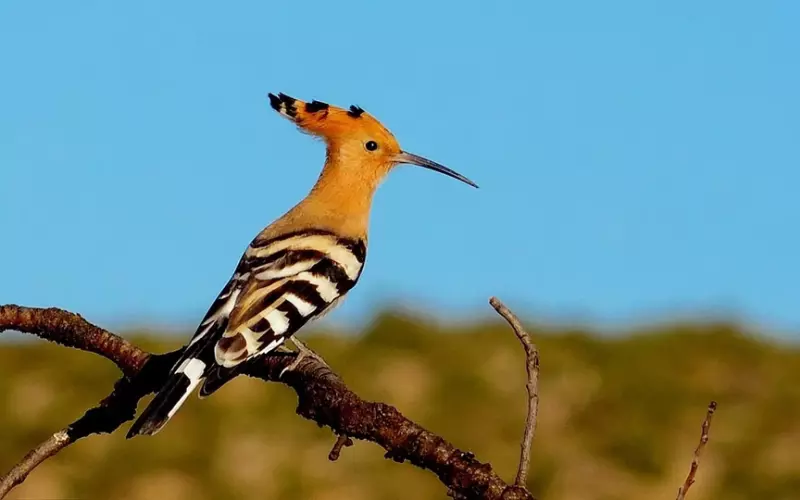
The population of Hoopoe birds is estimated to be around 17 million worldwide. These unique birds can be found in various regions, including Europe, Asia, and Africa. They are known for their distinctive crests and beautiful plumage, which include a combination of colours like orange, black, and white. While the exact population number is uncertain, this assumed figure can give us an idea of how many Hoopoe birds exist worldwide.
Unfortunately, if we were to talk about the extinction of Hoopoe birds, it would be a sad tale. These birds are not currently considered extinct, but discussing their possible extinction could help highlight the importance of protecting them. The loss of their natural habitats due to deforestation, pollution, and climate change could threaten their existence. We must take measures to preserve their habitats and ensure their survival for future generations.
To conclude, the assumed population of Hoopoe birds is estimated at 17 million globally. These birds have a distinctive appearance and can be found in different parts of the world. However, we must be aware of the potential risks they face to protect them and prevent the tragic extinction of this beautiful species.
Conclusion
Hoopoes are fascinating birds that have captured the attention of people throughout history. These animals’ distinctive appearance and exciting behaviours have left a lasting impression on many.
One of the most remarkable things about hoopoes is their historical significance. They have been mentioned in various ancient texts and are revered in different cultures. Their unique crown of feathers and intricate plumage make them a sight. Hoopoes’ ability to eat insects by probing the ground with their long curved bills is fascinating and essential in maintaining the balance of ecosystems.
Hoopoes are medium-sized birds that thrive in various habitats, including woodlands, savannas, and even human settlements. They are found in regions spanning from Europe to Asia and Africa. Despite their striking appearance, hoopoes are relatively shy and elusive creatures.
Overall, hoopoes are remarkable creatures that captivate naturalists and bird enthusiasts alike. With their exciting history, distinctive features, and adaptability to various environments, these birds continue to be a source of wonder and fascination for those lucky enough to witness their beauty.
Frequently Asked Questions about Hoopoe (FAQ’s)
What is a Hoopoe bird?
The Hoopoe bird is a medium-sized bird known for its distinctive appearance and unique behaviours.
Where can Hoopoes be found?
Hoopoes can be found in various parts of Europe, Asia, and Africa.
What do Hoopoes look like?
Hoopoes have a distinctive crown of feathers on their heads, long curved beaks, and pinkish-brown plumage with black and white markings.
What is the significance of the Hoopoe’s crown of feathers?
The crown of feathers can be raised into a fan-like crest, often displayed during courtship or as a territorial display.
What is the diet of a Hoopoe bird?
Hoopoes primarily feed on insects, such as beetles, ants, and grasshoppers. They also eat small reptiles, earthworms, and even small mammals.
How do Hoopoes catch their prey?
Hoopoes use their long curved beaks to probe the ground and crevices for insects and other small prey.
Are Hoopoes migratory birds?
Hoopoe birds are migratory, with different populations undertaking seasonal movements to find suitable breeding and foraging grounds.
How do Hoopoes communicate with each other?
Hoopoes have a variety of calls, including a distinctive “hoo-poo” sound, which gives them their name.
Do Hoopoes live in large groups?
Hoopoes are generally solitary or found in small groups, except during the breeding season when they form pairs.
What is the breeding behaviour of Hoopoes?
Male Hoopoes perform elaborate courtship displays, including flapping their wings, bowing, and raising their crests. They also dig nesting cavities in trees or soft soil.
How many eggs does a Hoopoe lay?
Hoopoes lay between 4 and 7 eggs, which both parents incubate for around two weeks.
How long does it take for Hoopoe chicks to fledge?
Hoopoe chicks fledge after around 24 to 31 days, but they may depend on their parents for food for some time.
Are Hoopoes considered a threatened species?
Hoopoes are not currently considered a threatened species, but some populations have experienced declines due to habitat loss and pesticide use.
Are Hoopoes considered beneficial for humans?
Yes, Hoopoes benefit humans as they help control insect populations, including pests that can damage crops or gardens.
Do Any conservation measures protect hoopoes?
In many countries, Hoopoes are protected by laws and conservation measures, such as habitat preservation and monitoring programs, to ensure their populations remain stable.

Hey there, I’m Kristen Haudenschild! I’m like a superhero for animals and people.
I work as a Dependable Hard Working Supervisor, which means I help both people and animals grow and learn. I did my school at OdySea Aquarium and Georgia Southern University in Tempe, Arizona. That’s where I learned all about animals, and guess what? I’m fascinated by them!
I even write cool articles about animals. My job history includes being an Animal Trainer and a Marine Mammal Trainer II at OdySea Aquarium. I’ve also been a Senior Animal Care Specialist and an Animal Care Specialist 2.
I love exploring animals and am always ready to help others learn more about them. So, if you ever need info about animals, give me a shout!

